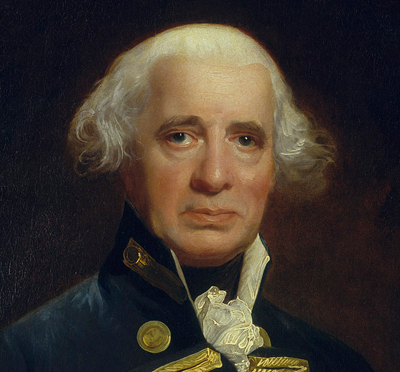What a Cur'Tis!
This print appeared just over a year after the "Glorious First of June," also known as the Fourth Battle of Ushant, the first major and much-touted naval victory in the war against revolutionary France. It features two figures who would have been well-known from that battle: the nominal victor himself, Sir Richard Howe, Admiral of the Channel Fleet, (familiarly known as Black Dick) and Sir Roger Curtis who was Howe's flagship Captain. Gillray would have been quite familiar with reports of the battle and its aftermath from the summer he spent in Portsmouth in 1794 sketching boats, sailors, rigging, cannons, flags and other naval personnel and equipment which would be featured in Philip James de Loutherbourg's monumental painting of The Battle of the First of June exhibited in March of 1795.

© Lewis Walpole Library, Yale University
To start, it is worth noting what the print does NOT show. It does not show (like the painting by Mather Brown), two commanding figures calm in the heat of a naval battle, standing up to firepower of the French, and leading their sailors to victory. What we see instead is an almost domestic scene of a man with his dog. Indentifiable by his naval uniform and a strong likeness to the painting by John Singleton Copley, Admiral Howe sits comfortably in an armchair wearing a military tricorn hat, smoking a pipe in what is likely his quarters at his home base in Torbay with a glass of port at his side and a punch bowl behind him. Judging from the date of the Gazette in his hand, he is (still) reading about himself and his victory over a year ago.

Richard Howe, 1st Earl Howe [1794]
© Wikipedia
Gillray had portrayed Howe in an earlier print, A French Hail Storm (12/10/1793) as mercenary and self-serving, driven by money and self-interest to spend more time in the cushy quarters of Torbay than in patrolling the seas near Brest. But the comfortable setting with a safely distant view of the sea, the map of Torbay, and the year old Gazette may be more than simply a clue to Howe's location and identity. It is likely meant to recall his earlier reputation.
At the feet of the self-satified Howe, is the "Cur," Sir Roger Curtis, appearing as "Black Dick's Dog," if not licking his boots at least abjectly kissing his foot. Gillray's view of Curtis was shared by at least one of Howe's Captains, Cuthbert Collingwood, who described Curtis as "an artful, sneeking creature, whose fawning insinuating manners creeps into the confidence of whoever he attacks and whose rapacity wou'd grasp all honours and all profits that come within his view." In fact, Curtis was promoted to to Rear Admiral in July and granted a baronetcy in September of 1794, no doubt at the recommendation of Howe.
As Gillray would have heard as he made his sketches of boats and rigging in Portsmouth, and as Timothy Jenks details in his dissertation, there was considerable discontent among the participants of the Battle of the First of June about the subsequent inequity of recognition and the division of the spoils. The nature of the battle made it virtually impossible for Howe to have a good view of the performance of his men, and yet Captains mentioned in Howe's final report of the battle were rewarded; Captains overlooked were not. And indeed the detailed report was suspected to have been written, at least in part, by Curtis. If one of those neglected officers had, as Gillray pretends, drawn a portrait of Howe and Curtis, it would, in fact, have looked a lot like Gillray's print "published as a Guide to Preferment." And its conclusion would have been much like what we see—if you want to get ahead (like Curtis) you have kiss the feet of your superior officers.
But why would Gillray turn to this satiric view of Howe and Curtis in June of 1795? One reason could be the anniversary of the battle itself. But the other, probably more compelling, is that both men were once again in the news from April 28 until May 14, 1795 at the court martial of Anthony Malloy, one of Howe's Captains accused of
not having brought up his ship, and exerted himself to the utmost of his power, in the engagements which took place on the 29th of May, and 1st of June, 1794.
(St James's Chronicle April 28, 1795, p. 1)
Gillray would have appreciated the several ironies: that the great avoider of battles, Howe, was the official Prosecutor in the case and that, owing to a flareup of his gout (too much port and punch), he was unable to perform his duties, and that the cur, Sir Roger was (of course) delegated to take his place.
Sources and Reading
- Commentary from the British Museum on What a Cur'Tis!.
- "Richard Howe, 1st Earl Howe," Wikipedia
- "Roger Curtis," Wikipedia
- "Glorious First of June," Wikipedia
- "History of Torquay," Wikipedia
- Timothy Jenks, Naval Engagements: Patriotism, Cultural Politics, and the Royal Navy 1793-1815, New York, 2006
- Professor N.A.M. Rodger, Commissioned Officers' Careers in the Royal Navy,1690-1815
- Thomas Wright and R.H. Evans, Historical and Descriptive Account of the Caricatures of James Gillray #128 .
- Thomas Wright and Joseph Grego, The Works of James Gillray, the Caricaturist; With the History of His Life and Times, p. 190.
Comments & Corrections
NOTE: Comments and/or corrections are always appreciated. To make that easier, I have included a form below that you can use. I promise never to share any of the info provided without your express permission.